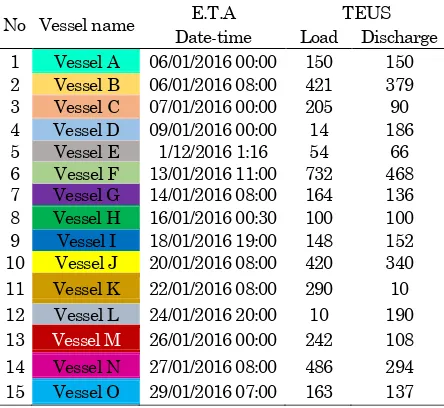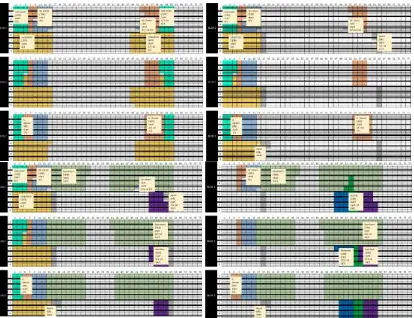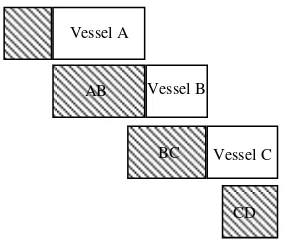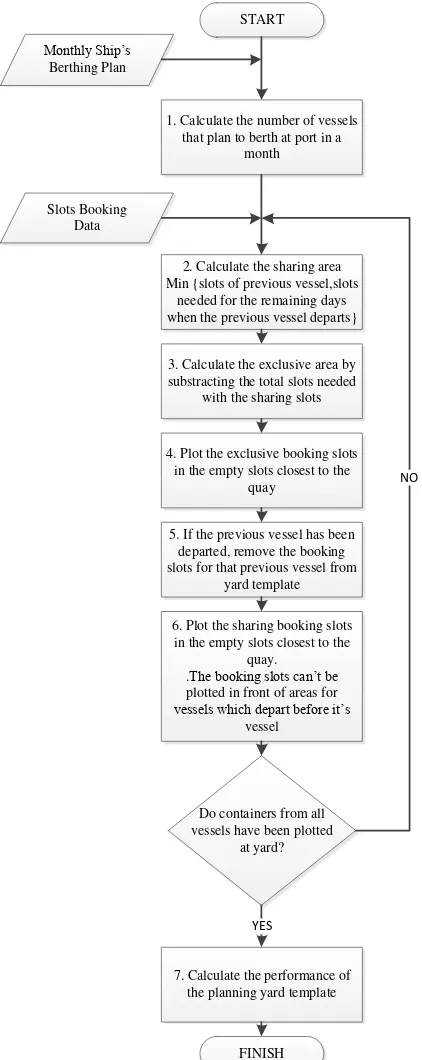Space-Sharing Strategy for Building Dynamic Container Yard
Storage Considering Uncertainty on Number of Incoming
Containers
Siti Nurminarsih1*, Ahmad Rusdiansyah2, Maulin Masyito Putri1
Abstract: The implementation of AEC (Asian Economic Community) leads to demand increase at
ports in Indonesia. This increasing demand is followed by operational efficiency at the port as well. In fact, ports in Indonesia have an average dwelling time for 5 days. One of the causes of this long dwell time is container transfer inefficiencies during loading process. In this research, we will focus in yard management and increasing land utilization. To increase the land utilization, we develop the space-sharing concept to reduce the initial space needed for a given workload. Since the ships arrivals are also varying, this concept will be possible. We develop the concept by adding uncertainty on number of incoming containers at operational level as the determining factor in planning a shared yard area. We propose a simulation approach to evaluate strategies in making yard template. The numerical experiment clearly showed that sharing spaces outperformed vertical arrangement in both of total needed spaces and loading distance. In this case, we conclude that sharing spaces strategy enables efficiency in planning container yard template.
Keywords: Dwelling time, space-sharing concept, yard management, container yard template.
Introduction
The increasing of international trading leads to an increase of goods which distributed through sea. Drewry Shipping Consultants in Jiang et al. [1] stated that annual container traffic has increased up to 5 times, from 87,947 million TEUs in 1990 to 463,634 million TEUs in 2009. Of the total container traffic, UNCTAD [2] stated that in 2010, there were more than 80% of the container in global trading shipped by maritime transportation. The intensity of using maritime transportation as a means of goods distribution makes the container port has a signi-ficant role, which is a gateway to the international trade.
In Indonesian Maritime Development Program, Indonesian government plans to increase the num-ber and frequency of container ships who sailed across Indonesian islands. The aim of this plan is to increase the distribution efficiency in Indonesia. Lately, several large vessels measuring more than 3000 TEUs have been operating on domestic ship-ping in Indonesia. Furthermore, with the imple-mentation of AEC, the number of foreign ships entering Indonesia are increasing. The addition of the vessels causes container traffic in the ports increase.
1 Faculty of Industrial Technology and Agro-industry, Department of Logistics Engineering, Universitas Internasional Semen Indo-nesia, Jl. Veteran, Gresik 61122. Indonesia
Email: siti.nurminarsih@uisi.ac.id, maulin.putri@uisi.ac.id 2Faculty of Industrial Technology, Industrial Engineering Depart-ment, Institut Teknologi Sepuluh Nopember Surabaya, Kampus Keputih Sukolilo, Surabaya 60111, Indonesia.
Email: arusdian@ie.its.ac.id * Corresponding author
The increasing traffic should be followed by infras-tructure preparation and operational efficiency at the port. In fact, ports in Indonesia have an average dwell time for 5 days. This is significantly lower compared to ports in Singapore, which is only 1 day. The high dwelling time will be an obstacle of distribution in Indonesia and linkages plan with international logistics.
The causes of this long dwell time are the com-plicated bureaucracies, the scarcity of land for con-tainer yard and a concon-tainer transfer inefficiency during loading process. Operational constraints at the container yard are usually caused by a scarcity of the land and infrastructure in the port. Increasing demand and the scarcity of the land and infras-tructure at the container yard led to the need for yard management.
Figure 1. Container yard configuration
Research on operation optimization in the container yard is focused on the factors that cause inefficiency in the yard area, which are the number of containers reshuffle and traffic congestion. Lee et al. [4] and Han et al. [5] conducted research that combine the optimization of the number of reshuffle and traffic congestion to make yard planning in the trans-shipment terminal. Lee et al. [4] introduced consign-ment strategy to minimize reshuffle by locating export and transshipment containers at the dedi-cated area based on the ships. “High Low Workload Traffic Balancing Protocol” was used to decrease the probability of traffic congestion. A mixed integer linear programming (MILP) then developed to deter-mine the number of containers that will come and cranes should be assigned to handle the containners. In 2008, Han et al. [5] developed research that has been conducted by Lee et al. [4] by considering area booking for each ship simultaneously. Jiang et al. [1] continued the research by suggesting the space-sharing concept as the solution to the lack of yard utilization that caused by the implementation of consignment. Jiang et al. [1] created a framework for the allocation of space-sharing plan for each ship arrival. However, this research is still done at the planning level where the uncertainty in the opera-tional level are not considered.
The uncertainty that occurs at the operational level is very high, for example due to weather or delays in operations at the previous port. The longer the ves-sel’s path, the higher the level of uncertainty. A few studies have examined port operations under un-certain environments (Alcade et al. [6]). Most of them studied the impact of vessel arrival time and ope-ration time in quay or berth areas. Han et al. [7] and Zhen et al. [8] studied about berth allocation and quay crane scheduling problem under those uncer-tainties.
At the yard areas, Zhen [8] addressed on the problem of planning a robust yard template under uncertainty in number of loaded and unloaded containers. These uncertainties affect the area of sub blocks in container yard (CY) which are assigned in exclusive or sharing mode for each vessel. The vessels visit a port periodically (weekly, 10-days, or biweekly). The number of containers which are loaded or unloaded from (or to) a vessel also fluctuates in each period. The traffic congestions in the yard and multiple schedule cycle time for vessel arrival pattern are also considered in the developed model. Zhen [8] also developed metaheuristics method to solve the large-scale problems.
This research is proposed to apply the concept of uncertainty in number of incoming containers (Zhen [3]) and sharing area (Jiang et al. [1]) to solve the problem faced by one of container port in Indonesia. We propose a simulation approach to compare the performance of different template policies. The per-formance of yard template will be evaluated by the route length of containers in CY.
Problem Description
In this research, we observe one of international container port in Indonesia. The yard area in this port implements European Layout, which is fully automated yard. In the European Layout, the yard has blocks positioned perpendicular to the quay (see Fig. 1) and the I/O points are located at both ends of the storage blocks to respectively handle storages and requests from the seaside and landside (Carlo et al. [9]). The automated guide vehicles (AGVs) are used in seaside, while external trucks are on the landside.
In this port, the yard area consists of 6 blocks. 3 blocks for domestic shipping and 3 blocks for inter-national shipping. The width of each block, we call it row, is 9 slots container. The bay or the length of each block is 39 slots container. One slot container can accommodate one 20-feet container. The stack-ing height (tier) is 5 containers high, but because of the operational reason, yard operators’ usually only use 4 containers high. Each block has 2 Automated Stacking Crane (ASC). The first ASC works from front area to the middle and the other works from middle to the back. Figure 1 shows the configuration of container yard in this port.
Figure 2. The pattern of containers arrival (Jiang et al. [1])
From the data provided, we know that higher incom-ing workload always happen near vessel departure date. Even some containers arrive when ship already docked. The distribution of the container arrivals is shown in Figure 2 below. This behavior causes high inefficiency in the yard area because the booked spaces will be unoccupied until the real containers arrive. In fact, the real arrival containers sometimes different from the booked containers. Because of this problem, yard operators usually open less than 100% of the booked spaced on early booking day. At first, 30% of the booked spaced are opened and the percentage of opened booked space will be added if the incoming containers increase. By this strategy, the land efficiency will increase, but some containers for the same vessel may be placed far from others. This will cause the inefficiency of yard movements Since very few spaces are needed at the beginning of the booked time, some sharing spaces of one sub block can be lend to its neighbor. This space will be given back to that sub block after the departure time of the neighboring vessel. Since the departure time of each vessel isn’t the same, this scenario is possible to be implemented. In this port, because of the number of vessel that can be loaded or unloaded at the same time is 1, the operator divides the booked space for a vessel in to several blocks vertically. The purpose of this strategy is to speed up the loading/unloading process. But if more than one vessel can be loaded or unloaded at the same time, then this strategy become irrelevant.
A sub block is equal with the sum of containers slots for the same vessel. We calculate the shared spaces based on the difference of vessel estimate arrival time. In this research, we only consider the inter-national vessels. That is because we find many irregularities in domestic vessels operations. The international vessels from the same agent will arrive
at port at a certain frequent, namely monthly, weekly, or biweekly. We won’t consider irregular vessels that arrive at the port. Because we only consider the international shipping, we will only use 3 blocks in yard areas. From that information, we make a yard template for a month operation. First, we evaluate the best strategy to arrange containers in blocks and then we apply the sharing concept in making yard template. The slotting decisions in European Layout are very dynamic compared to Asian Layout. A single slot in different time bucket can be occupied by different container. This lead to an NP-hard problem that needs a lot of time to solve it with exact optimization. Thus, we choose simula-tion approach to solve this problem. These evalua-tions are evaluated based on the total distance between containers and I/O areas. The next section will describe the conducted simulation
Methods
In this research, we only consider the international vessels which have regular berthing time at the port. First, the simulation is about containers arrange-ment strategies in yard. The second simulation is about sharing space area determination for the given vessel schedule. The yard template will be evaluate based on the total distance between containers to the I/O areas. For the sharing space strategy, we also evaluate the slot utilization during the planning horizon.
Simulation on Container Arrangement Strategies
In this section, we evaluate between 2 strategies in containers arrangement, namely vertical and half blocks arrangement. These two strategies are chosen based on the practical experiences in the port. In vertical arrangement, the containers will be assigned to slots vertically in nearest area from the I/O point. The booked spaces for containers will be divided in all blocks. For the second strategy, the half blocks arrangement, the booked spaces for containers are also divided in all blocks. But in this strategy, the containers for the same vessels will be occupy half area of each block.
Figure 3. The container to slot assignment algorithm
Table 1. Comparison of performance evaluation between vertical and half blocks arrangement strategies
No Vessel name E.T.A TEUS Date-time Load Discharge 1 Vessel A 06/01/2016 00:00 150 150 2 Vessel B 06/01/2016 08:00 421 379 3 Vessel C 07/01/2016 00:00 205 90 4 Vessel D 09/01/2016 00:00 14 186 5 Vessel E 1/12/2016 1:16 54 66 6 Vessel F 13/01/2016 11:00 732 468 7 Vessel G 14/01/2016 08:00 164 136 8 Vessel H 16/01/2016 00:30 100 100 9 Vessel I 18/01/2016 19:00 148 152 10 Vessel J 20/01/2016 08:00 420 340 11 Vessel K 22/01/2016 08:00 290 10 12 Vessel L 24/01/2016 20:00 10 190 13 Vessel M 26/01/2016 00:00 242 108 14 Vessel N 27/01/2016 08:00 486 294 15 Vessel O 29/01/2016 07:00 163 137
Given the monthly schedule of international vessels, the configuration of yard template with vertical and half blocks arrangement strategy are described in Figure 4 and 5 respectively. The colours represent the vessel that load or discharge the containers. Table 1 show the example of vessel arrival schedule. Every vessel will be marked with different colour and has arrival date and number of loading and discharge containers. The results in Figure 4 and 5 verify the developed simulation algorithm can be used to make layout design that meet the rules. At those arrangements, the loading containers will be assigned to slots near the waterside, otherwise the unloading containers will be assigned to slots near the landside. The loading and unloading con-tainers will occupy the slots for 5 and 6 days respec-tively before (after) vessels departure. For example, from date 1 until 6, the containers for vessel 1 which depart first (represented by blue colour as in Table 1) will be assigned in to slot nearest to the waterside, followed by containers for vessel 2 (represented by orange colour as in Table 1) which depart after vessel 1 at date 6. After all containers from each
vessel have been assigned at yard, we calculate the total distance of containers. We use the formulation in Gharehgozli [10] to calculate the distance between each location of container to the I/O point. The formula of total container distance is described in equation (1).
𝑡𝑖𝑗= 𝑚𝑎𝑥{|𝑥𝑖− 𝑥𝑗|, |𝑦𝑖− 𝑦𝑗|} + 𝑧𝑖+ 𝑧𝑗 (1)
where
𝑖 : the location index 𝑖 (𝑖 = 1,2 … . 𝑛) 𝑗 : the location index 𝑗 (𝑗 = 1,2 … . 𝑚) 𝑡𝑖𝑗 : ASC travel distance frome node 𝑖 to
node 𝑗 (unit)
𝑥 : unit bay (𝑥 = 1,2, … 9)
𝑦 : unit row (𝑦 = 0,1,2, . . ,21); where 𝑦 = 0 -landside I/O point; 𝑦 = 21 -waterside I/O point
𝑧 unit tier (𝑦 = 1,2, … 5) (𝑥𝑖, 𝑦𝑖, 𝑧𝑖) : coordinate of node 𝑖
(𝑥𝑗, 𝑦𝑗, 𝑧𝑗) : coordinate of node𝑗
We simulate the 3 months data which are divided in to 3 monthly planning horizons. On each planning horizon, we calculate the performance of those two arrangement strategies. The result and comparison of performance evaluation between vertical and half blocks arrangement strategies are shown at Table 2. From that comparison of 3 months data, the perfor-mance of vertical arrangement strategy is better than the second strategy in handling the loading process. However, the result is slightly different with the performance of discharge process. In many cases, loading process is more important to minimize, because it affects the duration and cost of docking. So we conclude that the arrangement strategy which is already used by the port is good enough to make the yard template.
Results and Discussions
Simulation on Sharing Space Strategies
Figure 4. The yard template (from date 1-13) with vertical arrangement strategy
Figure 6. The concept of space sharing yard template (Jiang et al. [1])
In reality, the number of incoming containers some-times diver from the number of booked slots. It is because when forwarders make the consignment, the number of containers which will be loaded into vessel are still uncertain. This incompatibility will decrease the yard utility and sometimes the port will lose the opportunity in receiving other consignment. Jiang et al. [1] planned the shared area in the plan-ning level, which the size of sharing and non-sharing space is fixed during planning. The uncertainties in operational level aren’t consider yet. In this research we try to consider that uncertainty problem.
Space-sharing method allows some space to be shared between adjacent neighbors (Jiang et al. [1]). That method will help to reduce the original space needed for a given workload. In Jiang et al. [1], the container yard is divided into several sub blocks and between the neighboring sub blocks there are shared-spaces. The size of the shared-spaces can be static or variable. In static sharing space, the size of the sub blocks and shared-spaced are fixed. Otherwise the size of the shared-spaced in variable sharing space method can be adjust based on the results of the workload assignment. Figure 6 des-cribes the sharing space concept in Jiang et al. [1]. In this research, the exclusive-spaces and the shared-spaces are variable, which means the size of the exclusive and sharing areas are not fixed. It depends on the number of booking slots and the vessels departure days difference between two shared consignments. A vessel, namely vessel B, can has 2 shared-areas with 2 different vessels (vessel A and C). The departure day of vessel A and C will be before and after vessel A. With this method, the yard planner will be possible to adjust the total areas of each vessel if there is a discrepancy between the plan and the actual booking slot. The visualization of this arrangement can be seen on Figure 7. If the actual incoming containers of vessel B are larger than the
booked slots, the shared area between vessel B and C can be enlarged, so the exclusive area for vessel C will be smaller. Otherwise, if the actual incoming containers of vessel B are smaller than the booked slots, the shared area between vessel B and C can be enlarged. For the rest of this paper, this method of container yard arrangement is named dynamic space sharing yard template.
Based on historical data, the distribution of the incoming (loading) containers can be seen in Table 3. The average of incoming containers on the 1st day opening slot is 4%, 6% on the 2nd day, and so on. For example, if the vessels departure days difference between two shared consignments is 2 days, then the shared areas will be the minimum of 60% of the booked slots and the areas of the first vessel. The remaining area will be assigned as exclusive area for the second vessel. The procedure for assigning booked slots on the yard are described in Figure 8.
The procedure for assigning booking slots are start from monthly ship’s berthing plan. The first step is calculating the number of vessels that plan to berth at port in a month. The booking slot will be assign to yard by the order of vessels departure. The booking slots for vessel which depart earlier will be assigned to yard first. If there are more than one vessels which depart on the same day, the containers for those two vessels won’t be arranged on the same block. For each booking, the sizes of sharing and exclusive areas are calculated.
Figure 7. The concept of dynamic space sharing yard template
Table 3. The distribution of incoming containers at port
H-5 H-4 H-3 H-2 H-1 Arrival
percentage 4% 6% 20% 30% 40% AB
BC
CD Vessel A
Vessel B
Vessel C
Table 2. Comparison of performance evaluation between vertical and half blocks arrangement strategies
Arrangement strategy
Total ASC travel distance (meter)
Month-1 Month-2 Month-3
START
1. Calculate the number of vessels that plan to berth at port in a
month
2. Calculate the sharing area Min {slots of previous vessel,slots
needed for the remaining days when the previous vessel departs}
3. Calculate the exclusive area by substracting the total slots needed
with the sharing slots
4. Plot the exclusive booking slots in the empty slots closest to the
quay
5. If the previous vessel has been departed, remove the booking slots for that previous vessel from
yard template
6. Plot the sharing booking slots in the empty slots closest to the
quay.
.The booking slots can’t be
plotted in front of areas for
vessels which depart before it’s
vessel
Monthly Ship’s
Berthing Plan
7. Calculate the performance of the planning yard template
FINISH
YES
NO
Figure 8. The procedure for assigning booked slots on the yard template
The sharing area will be the minimum slots between the area of previous vessel and the slots needed for the remaining days when the previous vessel departs. After calculating the sharing area, the exclusive area can be calculated by subtracting the total slots needed with the sharing slots. Those exclusive and shared areas are plotted in the yard template according to the periods. So the slots of the container yard for each period can be occupied by containers from different vessels.
Table 4. Ship’s berthing plan
No Vessel name E.T.A Loading 4 Norhtern Volition 06/05/2016 732 5 Red Rover 2 08/05/2016 250 Sharing spaces 22885 257647,74 Vertical arrangement 31442 279470,66
These phases will be repeated until all of consign-ments for vessels are being plotted to the container yard. After all containers from all vessels are being plotted to the yard template, then the performance of the planning will be evaluated by calculating the slots utility and the total distance between contai-ners and I/O areas.
The scenario of vessels who visit port with monthly, 10 days, weekly, and biweekly frequent was develop-ed to evaluate the performance of propose procdevelop-edure. Every vessel has estimate time arrival and number of booking containers for loading activity (TEUS). The booking for discharge activity is not considered because the discharged containers can be in contai-ner yard for more than a month and there isn’t exact pattern that describe the flow of containers which leave the port. The data of ship’s berthing plan including number of booking slots for containers can be seen in Table 4.
The strategies’ performance on Table 5 shows that sharing spaces outperforms vertical arrangement in both of total needed spaces and loading distance. Sharing spaces strategy enables efficiency in plan-ning container yard template. But it requires more efforts to divide the booking into several sub blocks, check the availability of the yard and place the containers. In the crowded ports, the implementa-tion of this strategy won’t be possible without com pu-terized tool for decision support. Furthermore, it needs to evaluate the strategies with more scenarios to prove that sharing spaces strategy gives better performance in all aspects. The scenarios should show the variability of vessel berthing plan, booking slots, and actual arrival of containers.
Conclusion
This paper has evaluated strategies for arranging containers in container yard and proposed procedure for implementing dynamic space sharing yard template. The strategies that have been evaluated are vertical and half blocks arrangement. 3 months data have been used to compare the performance of those two strategies in making an efficient yard template. The performance is measured from the total distance between each container to the I/O points. The performance of vertical arrangement in arranging discharge containers sometimes worse than half blocks arrangement, but it’s performance in arranging loading containers is clearly outperform the other. In this port, loading performance is more important than discharge, because it relates with berthing charge that imposed to the ship owners. So, we conclude that vertical arrangement is better than half blocks arrangement in making yard template. Sharing space strategy can be implemented in this port because the arrivals of loading containers are spreading along the booking horizon and increasing near the vessel departure. This strategy is applied according to the procedure that has been developed. The numerical experiment clearly showed that shar-ing spaces outperformed vertical arrangement in both of total needed spaces and loading distance. Sharing spaces strategy enables efficiency in plan-ning container yard template.
There are some research issues that can be enhance-ed in the future. Firstly, the concept of dynamic sharing spaces strategy need to be developed in mathematical model and solved by heuristics algo-rithm. Secondly, the domestic vessels are also need-ed to be considerneed-ed in making sharneed-ed spaces yard template.
Acknowledgment
The authors would like to thank the reviewers for useful suggestions that allowed us to improve the paper and the Agency for Research and Community Service of Universitas Internasional Semen Indo-nesia for the financial support of this study under Contract No. 11/KP.01/10-01/02.16
References
1. Jiang, X., Lee, L. H., Chew, E. P., Han, Y., and Tan, K. C., A Container Yard Storage Strategy for Improving Land Utilization and Operation Efficiency in a Transshipment Hub Port, Euro-pean Journal of Operation Research, 221, 2012, pp. 64-73.
2. UNCTAD, United Nations Conference on Trade and Development, Review of Maritime Trans-port 2010, Geneva, 2010.
3. Zhen, L., Container Yard Template Planning under Uncertain Maritime Market, Transporta-tion Research,Part E 69, 2014, pp. 199-217. 4. Lee, L. H., Chew, E. P., Tan, K. C., and Han, Y.,
An Optimization Model for Storage Yard Mana-gement in Transshipment Hubs, OR Spectrum, 28, 2006, pp. 539–561.
5. Han, Y., Lee, L. H., Chew, E. P., and Tan, K. C., A Yard Storage Strategy for Minimizing Traffic Congestion in A Marine Container Transship-ment Hub, OR Spectrum, 30, 2008, pp. 697–720. 6. Alcalde, E. M., Kim, K. H., and Marchan, S. S.,
Optimal Space for Storage Yard Considering Yard Inventory Forecasts and Terminal Perfor-mance, Transportation Research, Part E 82, 2015, pp. 101–128.
7. Han, X. L., Lu, Z. Q., and Xi, L. F., A Proactive Approach for Simultaneous Berth and Quay Crane Scheduling Problem with Stochastic Arrival and Handling Time, European Journal of Operation Research, 207, 2010, pp. 1327-1340. 8. Zhen, L., Lee, L. H., and Chew, E. P., A Decision Model for Berth Allocation under Uncertainty, European Journal of Operation Research, 212, 2011, pp. 54–68.
9. Carlo, H. J., Vis, I. F. A., and Roodbergen, K. J., Storage Yard Operations in Container Termi-nals: Literature Review, Trends, and Research Directions, European Journal of Operation Rese-arch, 235, 2014, pp. 412–430.
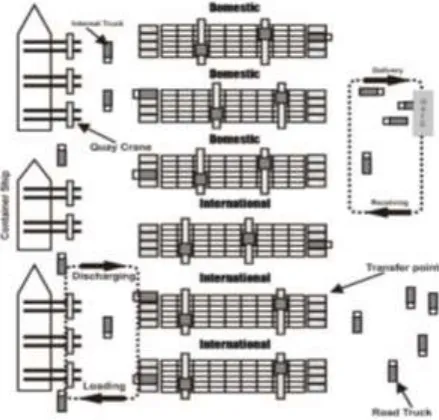
![Figure 2. The pattern of containers arrival (Jiang et al. [1])](https://thumb-ap.123doks.com/thumbv2/123dok/3769536.1491326/3.595.72.296.88.259/figure-pattern-containers-arrival-jiang-et-al.webp)
